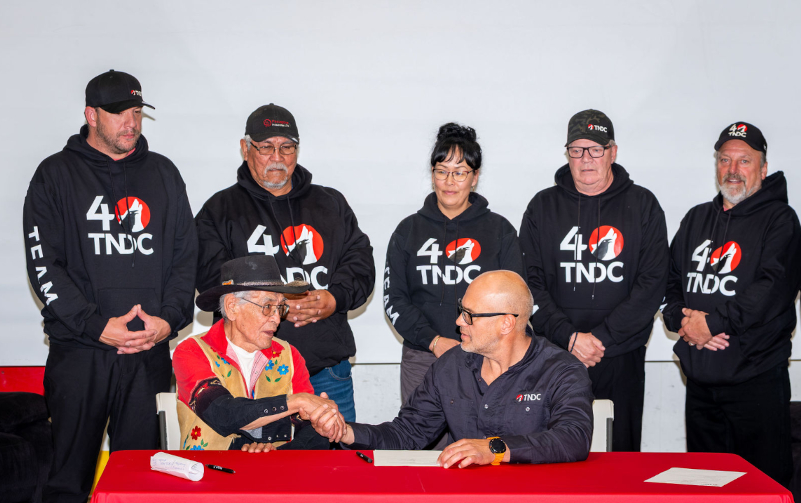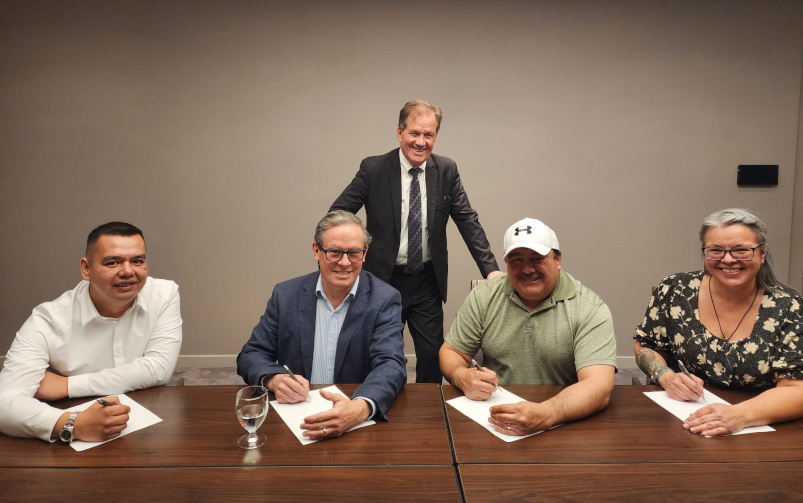Elesha Hoffarth, research and development manager at Tersa, built the synthetic biology program at the company.
The Equity Silver mine, in the backyard of the Wet’suwet’en First Nation in northwestern B.C., stopped producing in 1996. Since then, it has been under care and maintenance for acid rock drainage. The mine was formerly operated by Equity Silver Mines Limited and Goldcorp Inc., until Goldcorp was acquired by Newmont in 2019.
“This land can never be used by the Wet’suwet’en peoples again,” said Reg Ogen, president and chief executive officer (CEO) for the Yinka Dene Economic Development Limited Partnership (YLP), in an email to CIM Magazine.
“If we can find the right remediation technology, we can reduce this harmful process,” he wrote.
YLP is a corporation that acts as the business and economic development arm of the Wet’suwet’en First Nation. Last September, YLP entered into a strategic partnership with Tersa Earth Innovations, a clean technology start-up based in Vancouver.
Tersa’s water remediation technology, TersaClean, was developed to extract metals from mining waste and to clean tailings water. Its potential benefits are both economic and environmental.
“Our common ground is a healthy and robust environment for existence, economics and ecosystems,” Ogen wrote.
Tersa’s technology is still at the pre-pilot stage, but the company wanted to develop a different model for engaging Indigenous partners. Rather than reaching out with a market-ready technology, Tersa started working on building a relationship with YLP before it began approaching mines on Wet’suwet’en territory. The two partners also have a revenue-sharing agreement in place to share the profit TersaClean may generate on Wet’suwet’en territory.
“How we come to the table is, we step back and allow [YLP] to lead,” said Barinder Rasode, co-founder and CEO of Tersa.
In 2024, YLP approached Newmont to solicit its interest in demonstrating a proof of concept of Tersa’s technology in an industrial setting. The three companies have since been developing a relationship over the past six months to utilize Tersa’s technology to address Equity Silver’s acid rock drainage.
Though there is no formal agreement in place at this time, all three businesses worked together to put forward an application to the BC Fast Pilot program, a joint initiative between the National Research Council of Canada’s Industrial Research Assistance Program and Innovate BC.
If things keep moving forward, Rasode said that YLP “will have the agreement with Newmont, and we hope to be the supplier of the service.”
A new technology
TersaClean uses two microbial processes; one to extract metals from waste and the other to neutralize the water. They are designed to be used together for water treatment but can also be split up based on client needs.
The systems are contained in modules that can both fit within the size of a 40-foot shipping container for pilot-scale deployment. Water affected by acid rock drainage gets pumped into them.
For the first process, microbial fuel cells remove valuable metals, like copper, gold and silver, that are contained within water contaminated by the acid rock drainage and would otherwise be lost as waste. The microorganisms in the fuel cells generate electricity as they break down organic matter. Through bioelectrical reduction, the microbes separate the metals from the wastewater. The metals get deposited on electrodes, from which they are ultimately collected and sent to a refinery. The process is similar to electrowinning but uses a different energy source since the microbes generate electricity in the system.
In the second half of the process, microbes generate carbonates that combine with leftover toxic or undesirable metals in the waste. They precipitate into solid form and settle out of the water. Some of the carbonates get cycled back into the system to neutralize the acidic water’s pH, which removes the need for lime as the neutralizing agent; Tersa’s technology only needs an initial external neutralization agent, like magnesium carbonate or sodium hydroxide, to put the microbes to work and let them take over.
“By using the carbonate precipitation instead of lime neutralization, we can also reduce the amount of sludge that comes out at the end,” said Elesha Hoffarth, research and development manager at Tersa.
Skipping the sludge is one of the main elements setting Tersa apart from most of its biological and electrochemical remediation competition. Another advantage is that by foregoing lime, less carbon dioxide gets released.
The Minerals Research Institute of Western Australia estimates that there is US$3.4 trillion’s worth of lost critical minerals in mining waste globally. Using the remediation process to extract them is Tersa’s economic proposition to mining companies.
“Mining companies grapple with who is going to pay for waste remediation,” Rasode said. “So this is potentially a way for the company, the industry to pay for it.”
Until a pilot can be conducted and proves conducive, the technology remains unproven, but Tersa is seeing encouraging lab results so far with samples from BHP and Newmont sites. Rasode said the company is currently able to remove nearly 100 per cent of contaminants, like arsenic, from acid rock drainage and recover 95 per cent of metals. Among those metals, Tersa’s most promising extraction rates include critical minerals like copper, aluminum and cobalt.
Tersa’s water remediation technology currently stands at a technology readiness level of five out of nine, as defined by the federal government, which means basic components of the technology are being tested together as an integrated process in a simulated environment. The pilot stage happens at level seven.
Tersa started working with BHP in 2023 and Newmont in 2024 to test its technology using water affected by acid rock drainage from their sites.
Ogden wrote that YLP has been building its own relationship with Newmont since 2013. YLP participates in regular meetings and has gained a proactive understanding of Newmont’s remediation system at Equity Silver.
Until Tersa’s technology is proven, there are no guarantees on the metal recuperation potential at mines in the Wet’suwet’en First Nation’s territory.
“We’re not going in with the promise of great prosperity,” Rasode said. “We’re going in with the promise of, we’re going to be partners and work on this together and share whatever comes of it.”
Together from the beginning
Tersa approached YLP early on in its road towards the commercialization of TersaClean. “Tersa’s invitation to be at the table before the menu is set means a lot in the building of trust,” Ogen wrote.
He added that YLP is used to receiving such invitations once planning, strategy and implementation are already completed. “We find that disrespectful,” he wrote. “In this case, Tersa’s vision of inclusivity and participation at the early stages is rare, but both parties recognized that there are tangible and non-tangible benefits.”
Ogen believes that if Tersa approached YLP after the technology was already commercialized, it would have meant fewer opportunities for YLP, and its relationship with Tersa would not be as “robust and dynamic.”
YLP does not yet have a financial stake in the technology but has assisted in grant and funding applications. It may choose to invest later down the line. “Our potential investment can also be placed on a stronger ground if we were involved at this stage; having intimate knowledge,” Ogen wrote.
The partnership between YLP and Tersa strays from the more common template that is seen in the mining sector, of companies reaching out to Indigenous communities during early work on a new mine.
Its focus on mine maintenance and closure provides a rarer model. “I haven’t actually heard of anything in that space yet, but I think it’s quite interesting,” said Cherie Brant, partner and national leader of Indigenous law at BLG in Toronto.
Brant is not involved in the partnership, but her law practice focuses on helping First Nations organizations to negotiate major natural resources agreements, including mining impact benefit agreements and renewable energy partnerships.
Brant advises her clients to do their due diligence when vetting partnerships and to consider proven technologies over pilot projects, especially if they are considering a financial stake.
She said she always urges caution because she has seen many examples of communities being taken advantage of or investing in early-stage technologies that do not end up coming together. Brant said her primary concern is the protection of a First Nation’s reputation and credibility.
“I’m always very cautious about new technology, but I’m also extremely supportive of economic development,” she said. “I don’t know this project, but I think with the right advisors and people at the table and a proper due diligence process, you can identify whether there’s a viable opportunity.”
A community mandate
Should Tersa’s technology prove commercially successful, YLP will stand to benefit. It has a revenue sharing agreement in place.
All of YLP’s profits are returned to the community to assist in its mandate of “increasing the well-being in the community for seven generations,” Ogen wrote, referring to a principle prescribing that decisions made in the present should keep sustainability in mind for generations to come. YLP’s mandate is achieved through five pillars: culture and language, health, training and employment, housing and governance.
The collaboration is also a means for YLP to foster training and employment opportunities to encourage more people to consider careers in the environment and natural resource fields, Ogen added.
The aim would be to have community members versed in western knowledge, Wet’suwet’en traditional ecological knowledge and holistic perspectives to “increase the well-being in our community through pride as contributors and co-managers of our unceded territory,” Ogen wrote.
“The really good projects and deals are when the benefits are felt by the community members themselves,” Brant said. Whereas companies in the mining industry find value in the social licence derived from collaborating with Indigenous partners, what makes such deals worthwhile for the latter are the social benefits.
“I can’t see that reconciliation obligation ever ending in the mining space, because it’s so complicated and complex,” Brant said. “I think that there’s still a lot of work to be done.”
Assistance and understanding are key elements of economic reconciliation from Ogen’s perspective. He stated that YLP is not interested in greenwashing projects. Though YLP supported TC Energy’s Coastal GasLink pipeline infrastructure project, Ogen wrote that the business has learned a lot from the project and has passed along positive and negative critiques to its proponent.
“For those wishing to design, install and profit from projects in the Wet’suwet’en First Nation territory, the key is to know our hopes and aspirations and join with us to create a framework that guides the parties,” he wrote. “One size does not fit all.”
He believes YLP’s partnership with Tersa fits within this vision of economic reconciliation because YLP is viewed as a contributing partner with valued input.
The respect of YLP’s and Tersa’s cultures, as well as a foundation of learning, sharing and transparency, have been the foundation for the partnership for Ogen.
Rasode said Tersa’s intention is to create “collective prosperity, collective responsibility and then collective accountability.”
Through the opportunity to recover critical minerals from waste while cleaning it up, land use for mining on Wet’suwet’en First Nation territory will become more efficient, and better for the environment, according to Ogen.
“If we have a healthy and resilient ecosystem, our culture and language will not be diluted,” he wrote.




